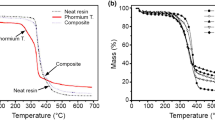Abstract
As acrylic fibres are heated in air to induce the stabilization reactions, the tension developed when stabilized at constant length and the instantaneous velocity of stabilizing fibres undergoing continuous processing both depend on the chemical composition, diameter, and orientation of the precursor fibre. An orientated fibre will tend to shrink when heated in the range 130 to 160° C, and hence will develop tension if restrained at constant length. Although this process has no direct relation to the stabilization process, it will influence the instantaneous velocity of the fibre during the later stages of continuous processing. As a fibre held at constant length is heated above 160° C the tension developed by entropic relaxation decreases and the fibre starts to undergo the prefatory and sequent reactions of stabilization described in a previous paper. If the prefatory reactions are rapid, a rigid structure is quickly established in the fibre and tension again increases rapidly. However, if the prefatory reactions are slow, select portions of the fibre react preferentially and the unreacted portions tend to relax to maintain a temporary quasi-equilibrium tension level. In both cases the fibres shrink at the later stages of stabilization because of chemical reactions. The shape of the tension-time curve is similar to the oxygen-uptake curves: The diffusion-limited mechanism of stabilization produces parabolic curves whereas the reaction-limited mechanism produces linear curves. Because each element of a fibre undergoing processing is subjected to the same tension at all times, previously orientated fibres first shrink, then stretch, and finally shrink again. These competing processes give rise to a changing instantaneous velocity. Data are presented for fibres of varying chemical composition, diameter, and initial orientation as well as for different conditions of stabilization.
Similar content being viewed by others
References
S. B. Warner, L. H. Peebles, D. R. Uhlmann,J. Mater Sci. 14 (1979) 556.
L. H. Peebles, “Encyclopedia of Polymer Science and Technology,” Supplement Vol.1 (Wiley, New York, 1976) p.1.
W. Johnson, L. Philips andW. Watt, British Patent, 1 110 791, US Patent 3 412 062.
H. Ezekiel, US Air Force Materials Laboratory, Technical Report No. 71–125 (1971).
G. K. Layden,J. Appl. Polymer Sci. 15 (1971) 1709.
W. Watt andW. Johnson,Appl. Polymer Symp. 9 (1969) 215.
M. J. Ram, US Patent 3 539 295.
A. K. Fiedler, E. Fitzer andD. J. Muller, Division of Organic Coatings and Plastics Chemistry, American Chemical Society (1971) 380.
E. Fitzer andD. J. Muller,Makromol. Chem. 114 (1971) 117.
D. J. Muller, E. Fitzer andA. K. Fiedler. International Conference on Carbon Fibres (The Plastics Institute, London, 1971).
O. M. Bahl andL. M. Manocha,Angew. Makromol. Chem. 48 145 (1975).
Private communication from the supplier (1977).
Author information
Authors and Affiliations
Additional information
Based in part on a thesis submitted by SBW in partial fulfilment of the requirements for the Sc.D. degree in materials engineering, MIT, 1976;
Rights and permissions
About this article
Cite this article
Warner, S.B., Peebles, L.H. & Uhlmann, D.R. Oxidative stabilization of acrylic fibres. J Mater Sci 14, 565–572 (1979). https://doi.org/10.1007/BF00772715
Received:
Accepted:
Issue Date:
DOI: https://doi.org/10.1007/BF00772715




